There are a few sites outside the actual modern city of Argos; some just outside the city and a few a bit farther afield. The first spot worth mentioning is atop the Larisa (or Larissa), the hill that overlooks Argos to the west. The name apparently comes from the name of the daughter of one of the Pelasgian founders according to Pausanias, or was perhaps the name of a group within the Pelasgian founders according to Strabo. The most significant remains on the top of the hill is from the medieval fortress constructed starting in the 12th century CE and subsequently repaired and embellished through to the 19th century CE. An ancient acropolis seems to have existed here since about the time of the Dorian migrations in the 13th century BCE. By the classical period, temples to Athena Polias and Zeus Larissaeus Pythaeus were located at the acropolis. Supposedly remains of these temple have been found, as well as some Hellenistic and Roman fortifications.
The Castle of Larisa is always open, there are no hours of operation or restriction of access. As such, it definitely has the feel of something that isn’t very well cared for; it was a bit overgrown in places and seemed a bit neglected. It’s not a huge time sink either, the whole area can be seen in 15 or 20 minutes, really. There are some signs, but, as the vast majority of what is here is from later periods, most of that focuses on the later periods. The signs are in English and Greek.
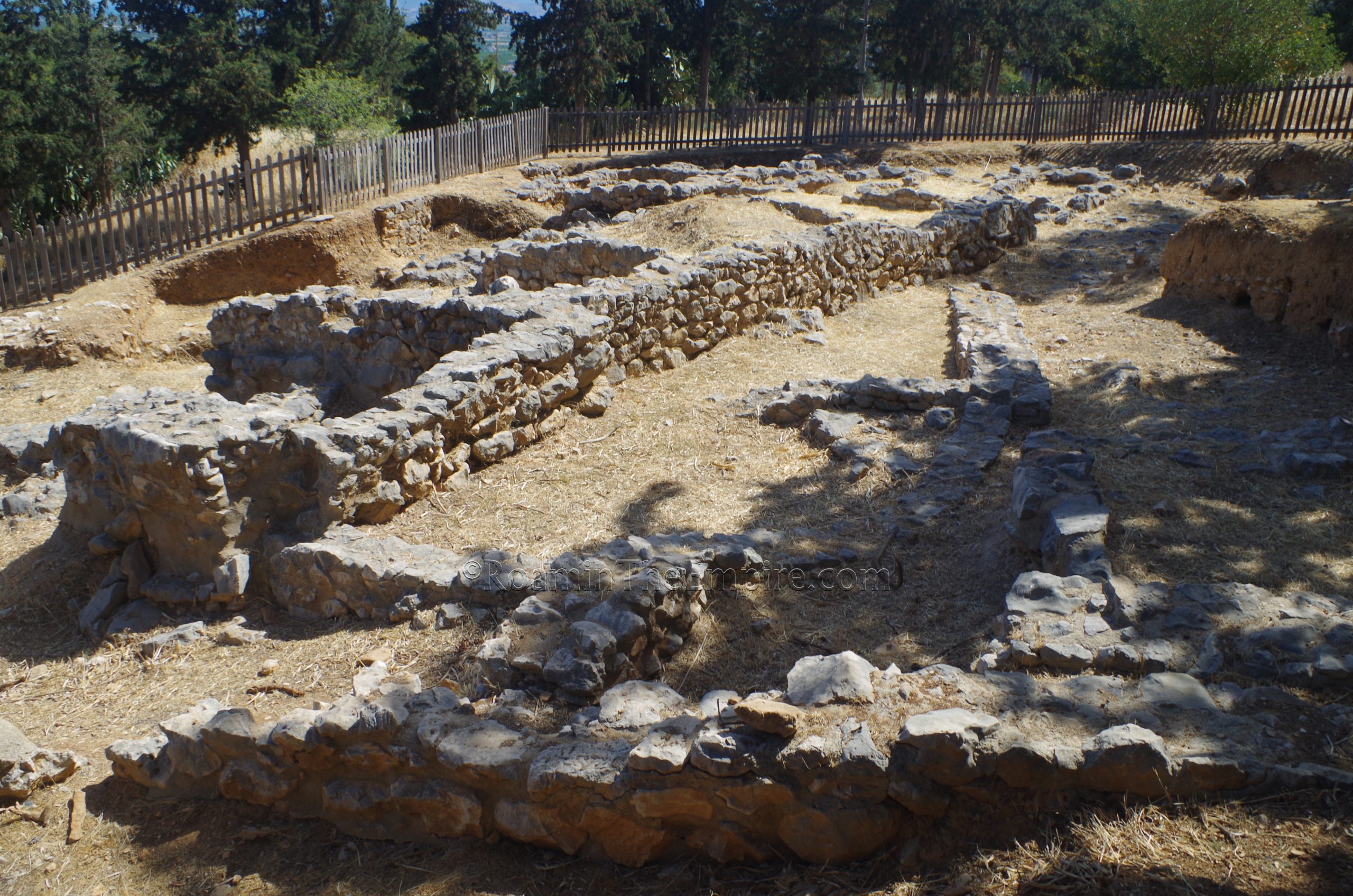
A much smaller hill on the north side of Argos is known now as the Aspida Hill, though it is sometimes referred to as Profitis Ilias after the 18th century church at its peak. In antiquity, it was Aspis and was first home to the Neolithic and Bronze Age settlement in the area of Argos. The entirety of the hill is a public park and seemed rather popular for walkers and joggers. The summit of the hill is accessible by vehicle, where there is some available parking. There is a gate at the road entrance to the hill, but, the hill is not fenced off, so, there would seem to be pedestrian access at all times, and the gate, I presume remains unlocked, at the very least, during daylight hours.
Starting about 50 meters north of the church and encompassing a just about 180 degree circuit of the summit of the hill are remains of the Aspis settlement. The excavated remains primarily date to the Middle Bronze Age/Middle Helladic period, roughly 2000 BCE to 1600 BCE. Most of what remains from this period seems to be residential structures and at the outermost ring, the fortification walls of the Middle Helladic settlement. The residential structures are visible mostly in two excavated areas due north and roughly due east of the church. The fortifications can be seen at both areas as well as an area excavated to the northeast.
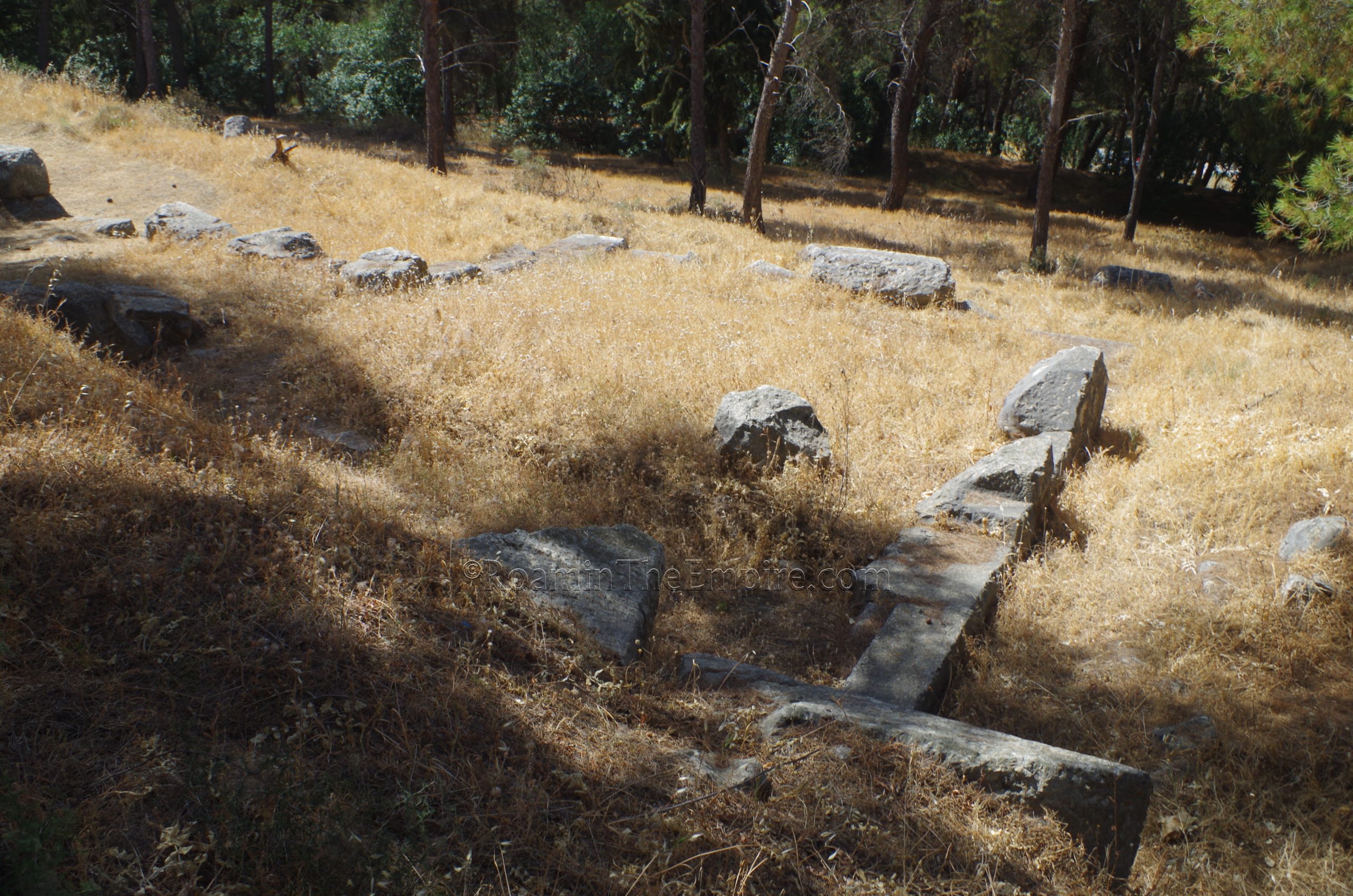
Just beyond the earlier fortifications are fortifications dating to the 4th century BCE. These are discernible from the Middle Helladic constructions in that they are composed of much larger blocks and can be seen at the northeast point along with a tower dating to this period. Long underground cisterns dating to the 4th century CE can also be seen at the eastern excavation point as well as a point south of the church. A pretty easy to follow trail runs from the north point all along the archaeological remains to the south point. At the eastern area is an informational sign with a diagram of the area and explanations in Greek, French, and English.
Further down on the slope of the hill are remains identified as temples to Apollo Deiradates, Apollo of the ridge, and Athena Oxyderces, clear sighted Athena. Pausanias describes these two temples as being part of the citadel of Larisa, but he may be including these as part of the Larisa. He does specific that the temple to Zeus Larissaeus was located as being at the top of the Larisa, in a different location. There seems to have been activity related to the sanctuaries at this location as early as the 6th century BCE. The remains of the temples and sanctuaries today date to the 4th century BCE with renovations in the 3rd century BCE and the 1st century CE. In the 5th century CE, a Christian basilica was built which was then replaced by another church in the 10th century CE.
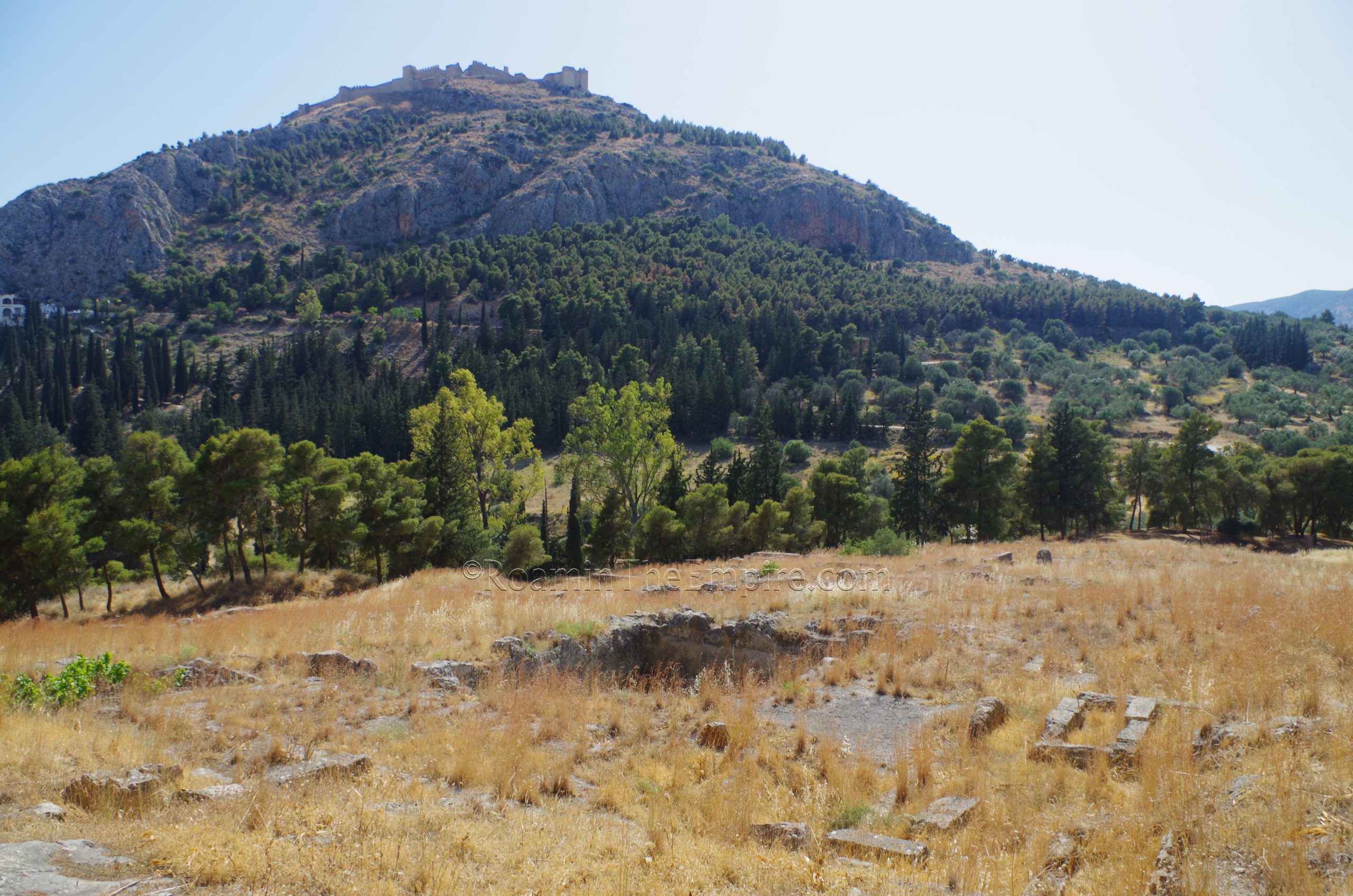
The Temple of Apollo Deiradiates, which may also reference the ancient name of the ridge, Deiras, was also known as the Temple of Apollo Pythaeus, as its building was attributed to Pythaeus, the son of Apollo, after he arrived in Argos from Delphi, This temple to Apollo was the site of an oracle. The priestess receiving prophecy here is noted as having to remain chaste and would receive prophecy after tasting the blood from a monthly nocturnal sacrifice of a lamb. The temple of Athena Oxyderces was said to have been dedicated by the Trojan War hero, and resident of Argos, Diomedes. He dedicated this temple to her after she removed the mist from his eyes during battle at Troy.
There is no kind of entrance or restrictions of access at the site, it is always open. A small parking lot is located at the bend in the road leading up the hill, to the north of the temple sites. The accessible and visible remains of the pre-Christian sanctuaries are a bit difficult to make out due to the vegetation growth and the remains of the later churches. Almost all of the pre-Christian constructions have since been removed, though there is quite a bit of rock cuts in the hill that indicate various elements of the sanctuary. One of the easiest elements to see is pretty much directly south of the bend in the road, what appears to be rock-cut steps leading from the lower terrace to the west to the upper terrace in the east. The constructions on the stairs belong to the Christian church. Directly to the west of the stairs is another smaller rock cut feature that is identified as being the altar of the Temple of Apollo Deiradiates. In antiquity, the rock would have made up the core and it would have been faced in masonry.
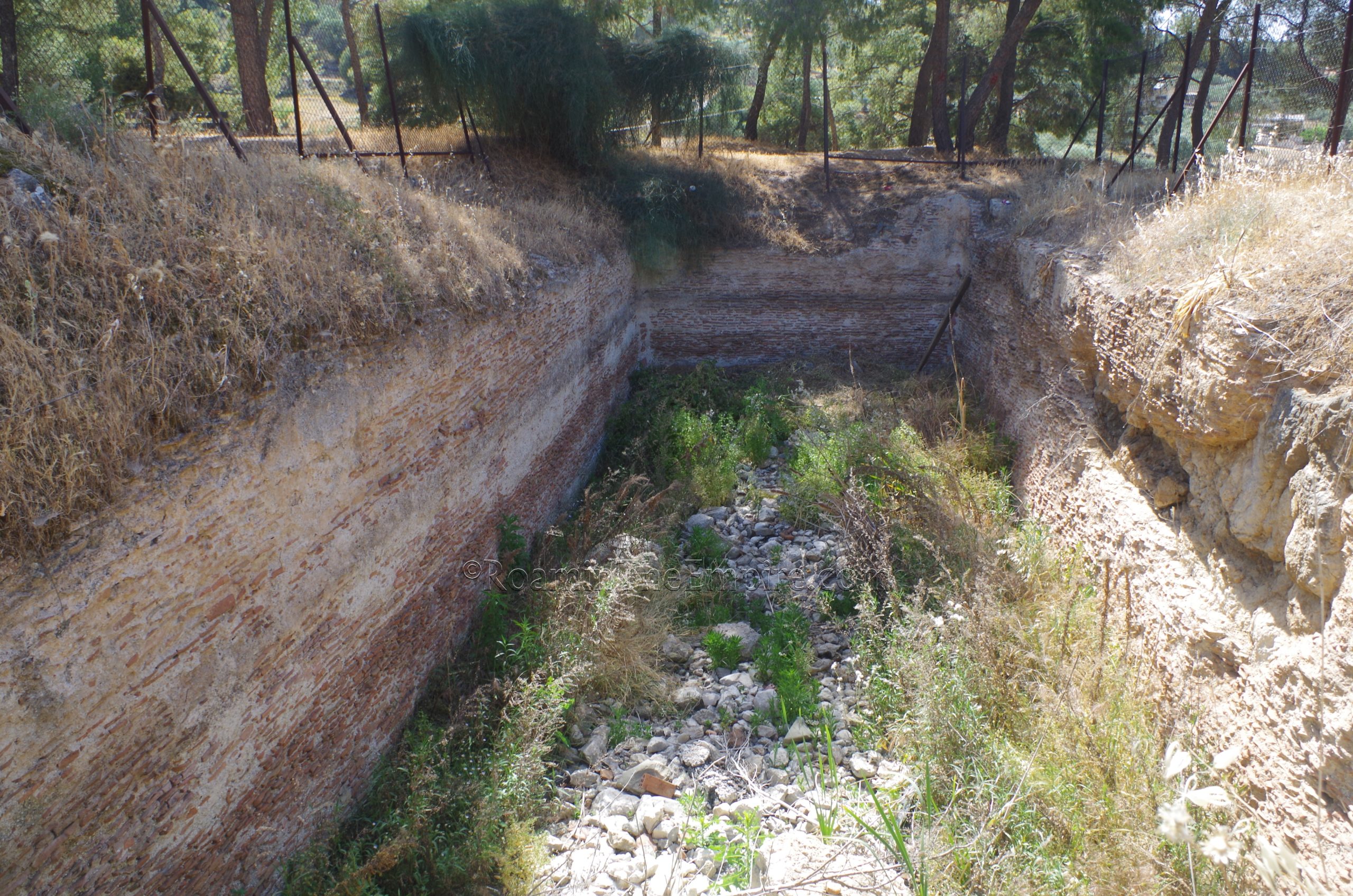
About 35 meters due west of the altar is a roughly 15 meter long subterranean structure that resembles a cistern. The brickwork certainly suggests a construction of the Roman or Byzantine period. Some plans show this to be roughly the proposed location of the Temple of Apollo Deiradiates, but it would seem to be more the form of a cistern than any sort of temple structure. It could be a cistern associated with the temple, though. On the upper terrace, east of the staircase, the most obvious feature is a cistern cut into the rock that was apparently part of a larger building. Some have identified the larger building as possibly being a sanctuary dedicated to Asclepius. Roughly south of this, and hard to really make out on the ground was apparently a tholos that may be associated with the Temple of Athena Oxyderces. Some step or seating-like carvings in the rock of the hill around this area are visible as well. Significant remains of the later Christian basilica can be seen in the south part of the terrace. Other than a sign noting the presence of the sanctuaries near the parking area, though, there’s no other information of any sort on site.
A Middle Helladic period cemetery is supposed to have been found at the foot of the hill, below the sanctuaries and adjacent to the Aspidos road. I could not, however, find any visible remains of the cemetery.
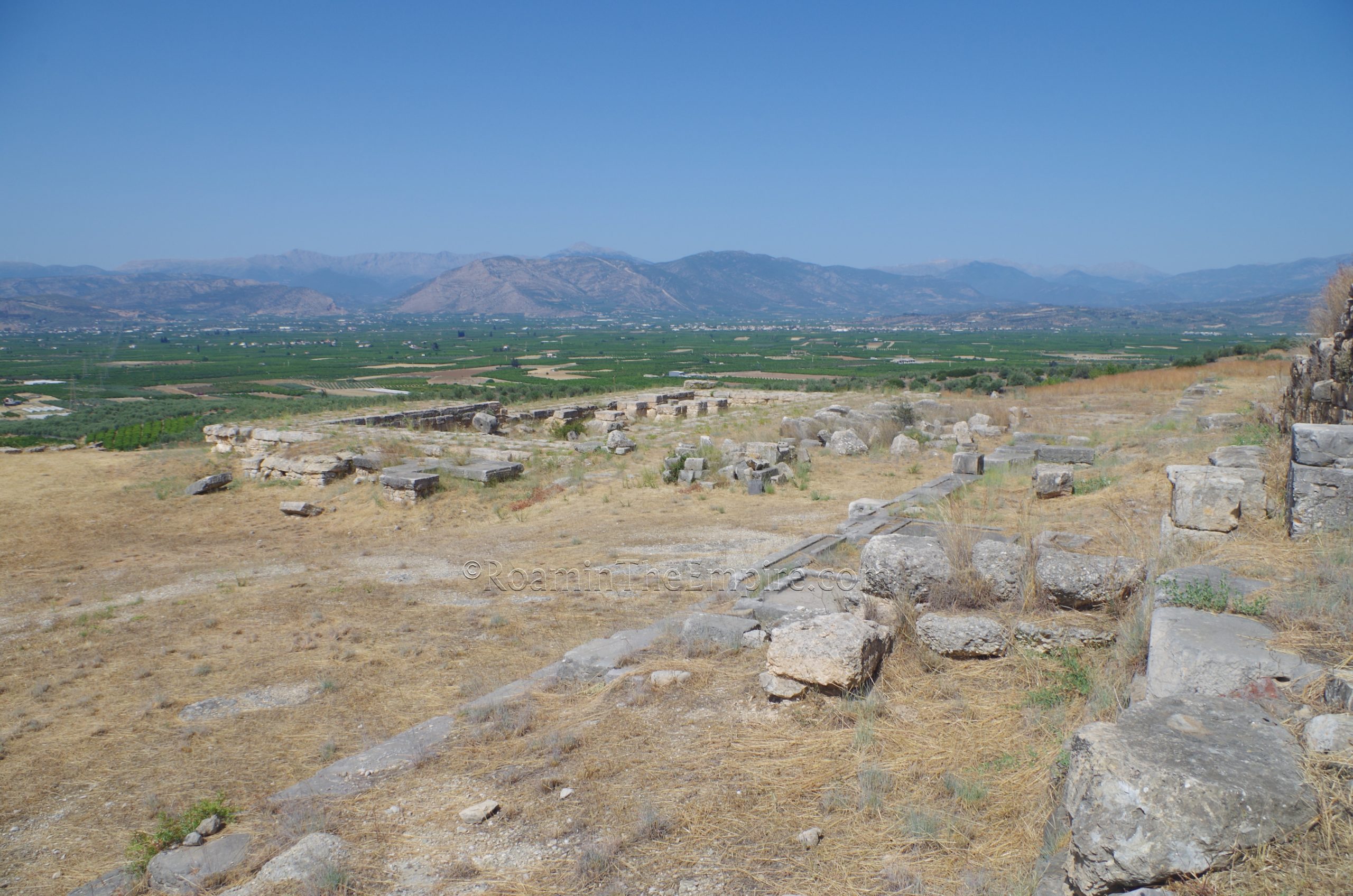
About 7 kilometers to the northeast is the Heraion of Argos, also called the Temple of Argive Hera. This site is a regulated archaeological area with regular hours an admission. Though admission is free, the sanctuary is open daily from 8:30 to 15:30, including Tuesdays, the typical closing day for many archaeological sites and museums in Greece.
The sanctuary of Argive Hera is actually closer to Mycenae than it is to Argos, but by the time the sanctuary was constructed in its present form, Mycenaean power had declined. A sanctuary seems to have been established here around the 9th century BCE. The Dictys Cretensis notes that Agamemnon was chosen at the Heraion to lead the Greek armies to Troy, which would seem to be indication that the sanctuary existed earlier than the 9th century BCE or possibly an anachronism in the later tellings of the epic. Though established earlier, much of what remains dates to between the 7th and 5th centuries BCE.
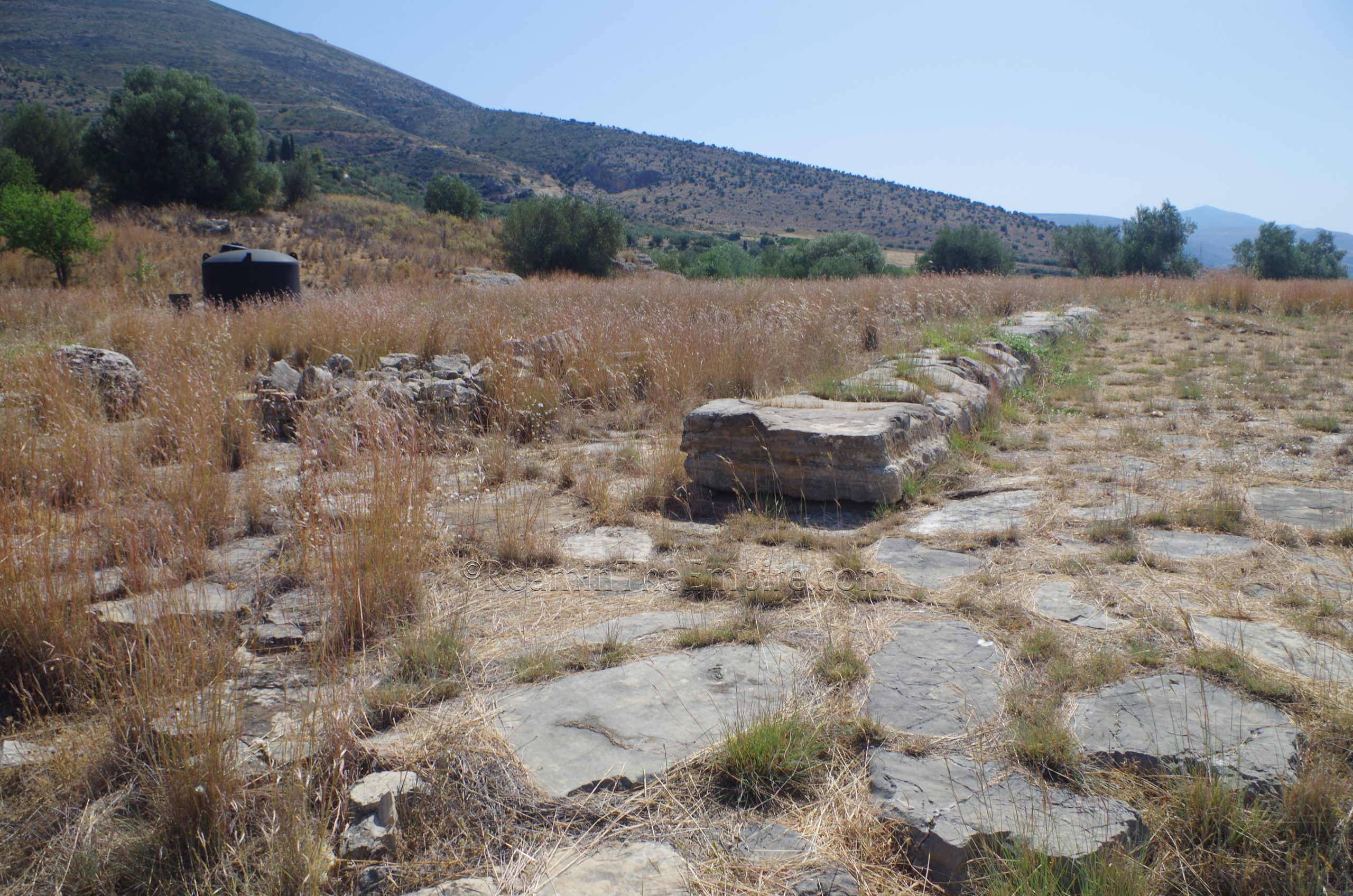
Composed of three terraces, the uppermost terrace was created with a monumental retaining wall in the late 8th or early 7th century BCE. This terrace housed the first temple, which was built around 625 BCE. This temple was destroyed in 423 BCE after an accidental fire attributed to the negligence of the priestess Chrysis, who fell asleep after laying a torch next to garlands and who subsequently fled Argos for fear of the consequences. Not much remains of this original temple, though the retaining wall made of large Cyclopean ashlars is visible looming over the rest of the site. A single course of blocks on the terrace, running on an east/west axis is pretty much all that remains of any structures on the terrace. There is direct access to the terrace at the site.
The second temple, constructed in the late 5th century BCE, was the focal point of the middle terrace. According to Pausanias, the temple was the work of the Argive architect Eupolemus. He also notes that the chryselephantine cult statue was sculpted by Polykleitos and that elements of the temple decoration included scenes of the Trojan War, also connected by the presence of a shield supposedly brought from.
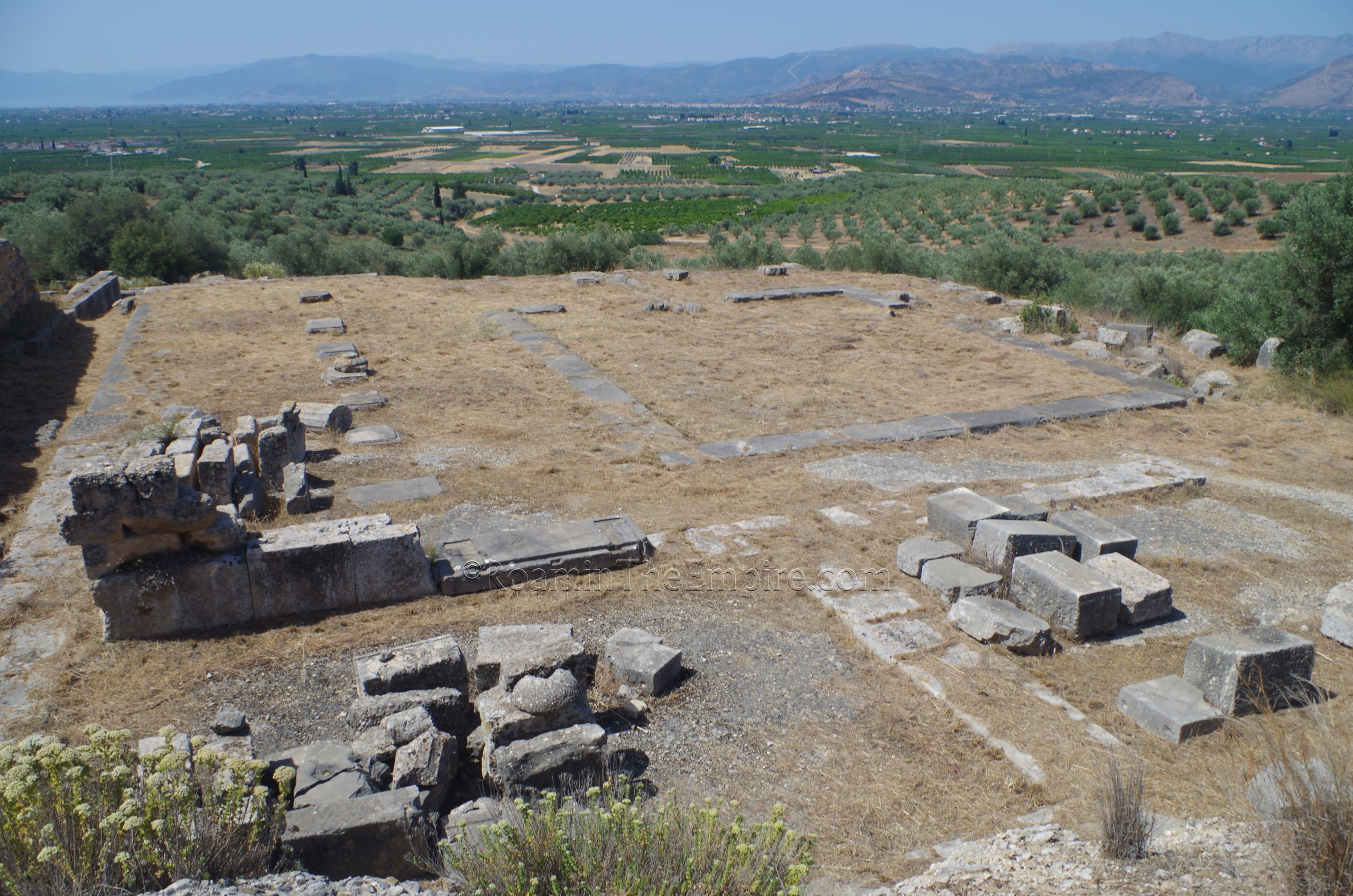
Troy by Menalaeus as one of the treasures housed there. Pausanias’ description and the presence of imperial inscriptions indicate that the sanctuary was functioning well into the Roman period. Also present on the middle terrace are two stoas north of the temple that abut the retaining wall of the upper terrace. A Hellenistic altar once stood east of the temple, though nothing remains. Farther east is a hypostyle hall that is interpreted as possibly being a space for the hosting of symposia. Both the stoas and the hall date to the 5th century BCE.
South of the temple, a monumental staircase descends to the lower terrace. Tucked between the staircase and the retaining wall of the middle terrace is another stoa, the south stoa, also dating to the 5th century BCE. The lower terrace bends around the middle terrace from the south and also runs up along the western side of the middle terrace. As it bends around to the north, is a square structure, the so-called west building. The construction of this building seems to date to the end of the 6th century BCE, though later dates of construction have been suggested. The form, with dining rooms off a peristyle courtyard suggest it may be a hestiatorion, an area for ritual dining. A few meters to the north is the northwest building, another structure dating to the 5th century BCE.
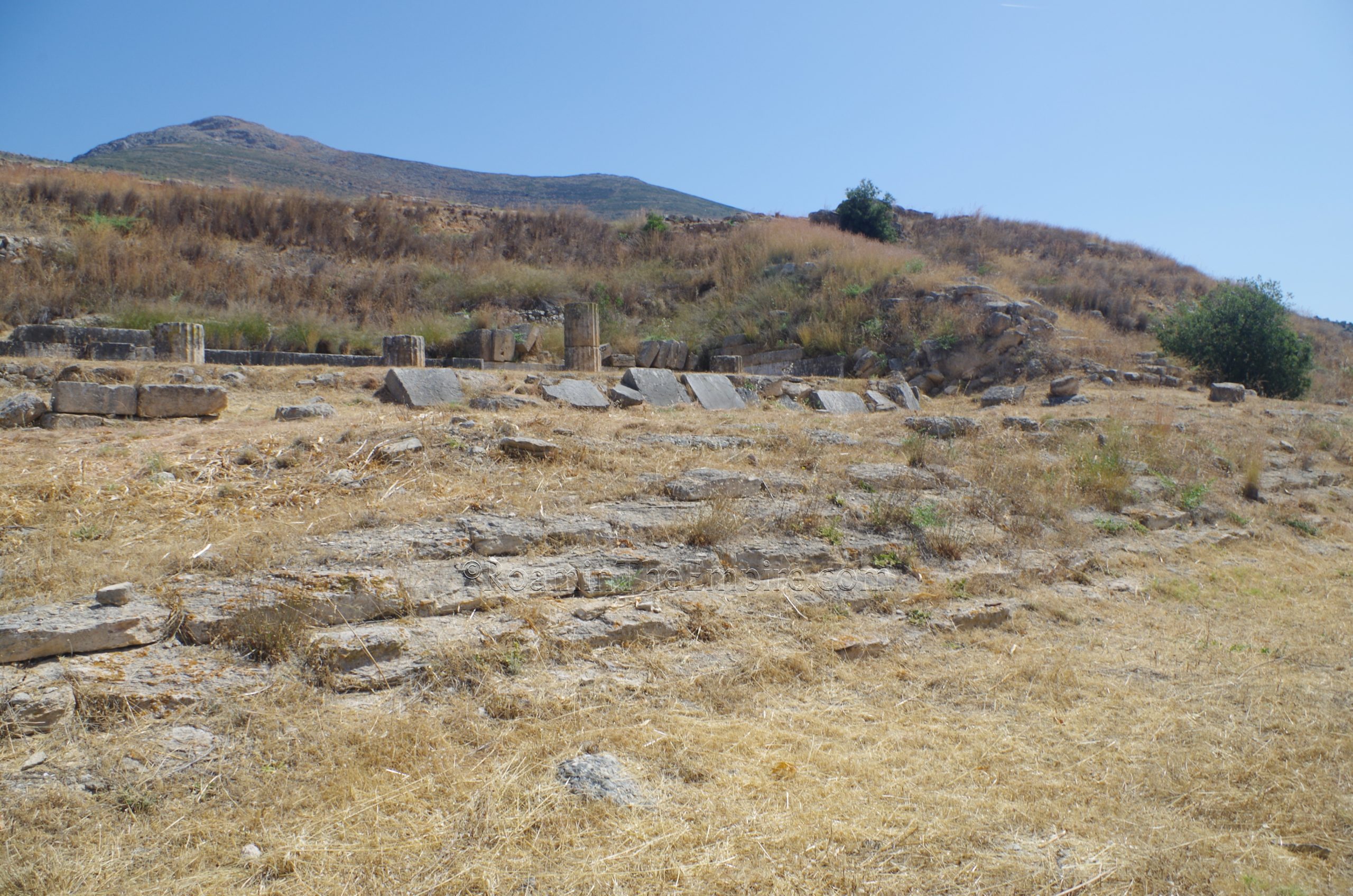
West of the two Greek buildings on the lower terrace are two later buildings dating to the Roman period. The southernmost of these is the palaestra, which may date from as early as the Hellenistic period. Not a whole lot remains visible of this structure other than part of the western wall. North of that is a Roman bathing complex. This too, is not well excavated and/or preserved, so identifying the individual rooms is not really possible on-site. They are a bit more robust and present than the palaestra, though.
It’s not an immensely large site, I was only there for about half an hour. It could probably be done as part of a full day with Argos; I wasn’t able to do it the same day because I planned the whole day at Argos proper, hoping that the archaeological museum would actually be open. There aren’t any informational signs at the Heraion, unfortunately. Most areas are accessible and open without any real restrictions, aside from overgrown areas that were not ideal for moving around.
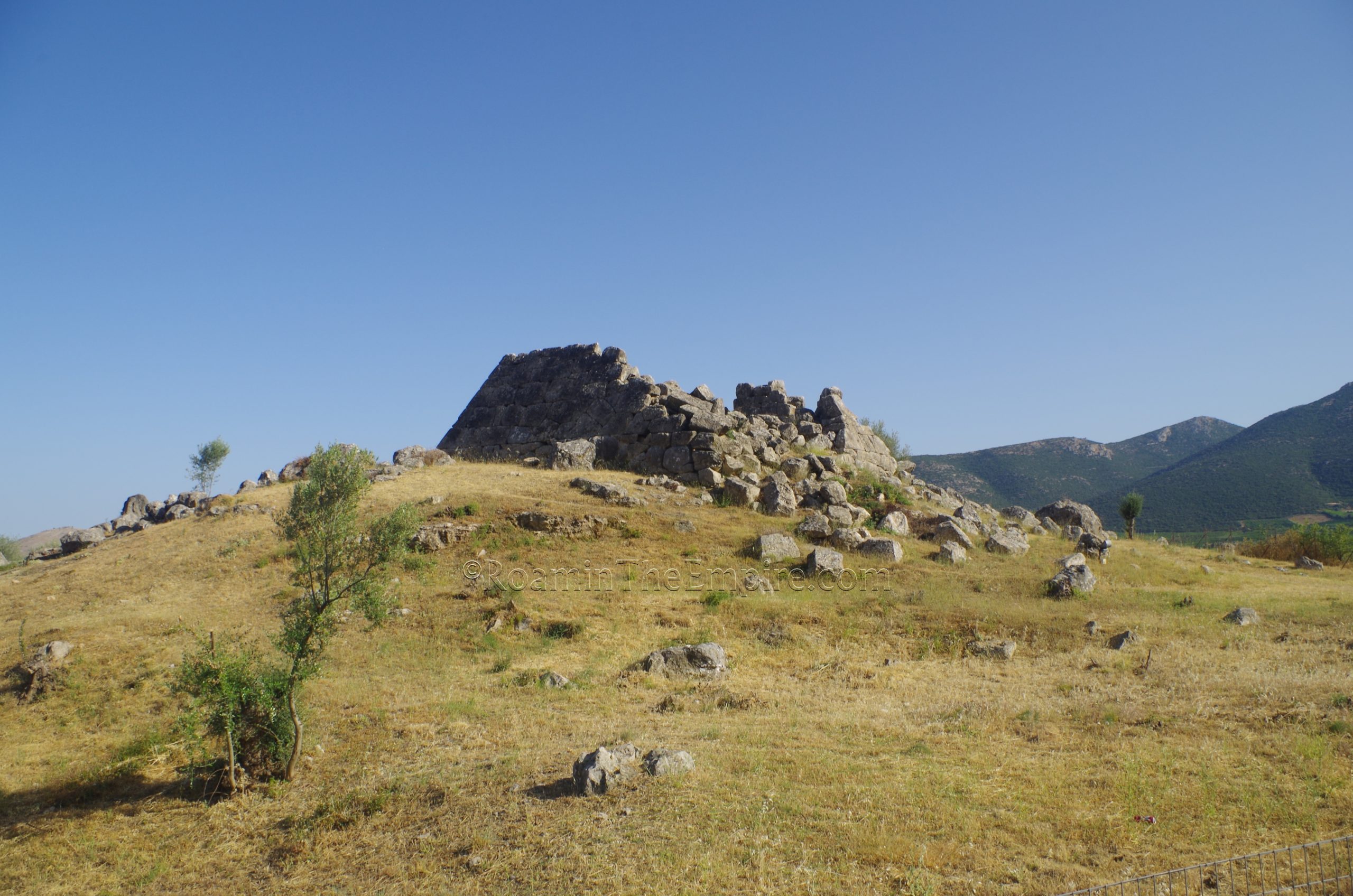
Another worthwhile stop near Argos, about 7 kilometers to the southwest, is the Pyramid of Hellinikon, or Elliniko, derivatives of the small village the monument stands near. It is also sometimes called the the Pyramid of Kechraie. The structure has a square base that then has sloped rises to give it a shape reminiscent of pyramids. The construction is preserved up to a few meters in some places, including the arched entryway. The exact function and dating is unknown. Pausanias mentions the presence of this, or a nearby pyramid that was a monument to a battle between Proetus and Acrisius for the throne of Argos and served as a common tomb for the soldiers who were killed. Other interpretations are that it is a communications tower or watchtower. Dating is similarly problematic with some analysis concluding it is early Hellenistic and others suggesting much earlier dates, perhaps as far back as the 3rd millennial BCE. The site is fenced, but there is an unlocked gate that allows access. Other than that, the site is essentially open without any kind of real restriction. There is an identification sign, but no other information on site.
Sources:
Diodorus Siculus. Bibliotheca Historica, 11.65, 12.75.
Grant, Michael. A Guide to the Ancient World: A Dictionary of Classical Place Names. New York: Barnes & Noble Books, 1997.
Hall, Jonathan M. Reclaiming the Past: Argos and Its Archaeological Heritage in the Modern Era. Cornell, NJ: Cornell University Press, 2021.
Herodotus. Historiai, 6.76-6.85, 6.92. 7.148-7.150.
Homer. Illiad, 4.51-52.
Livy. Ab Urbe Condita, 32.25. 34.25-34.41.
Longfellow, Brenda. “The Legacy of Hadrian: Roman Monumental Civic Fountains in Greece.” The Nature and Function of Water, Baths, Bathing, and Hygeiene from Antiquity through the Renaissance. Leiden: Brill, 2009.
Miller, Stephen G. “The Date of the West Building at the Argive Heraion.” Archaeology. Vol. 77, No 1 (Jan. 1973), pp. 9-18.
Pausanias. Hellados Periegesis, 2.15.5, 2.17, 2.19.3-2.24.4, 2.25.7, 2.26.1, 2.35.2, 8.27.1.
Plutarch. Aratus, 34-35.
Plutarch. Pyrrhus, 34.
Polybius. Historiai, 2.44, 2.52-2.54. 2.70.
Smith, William. Dictionary of Greek and Roman Geography. Walton & Murray, 1870.
Stillwell, Richard, William L. MacDonald, and Marian Holland. McAllister. The Princeton Encyclopedia of Classical Sites. Princeton, NJ: Princeton U Press, 1976.
Strabo. Geographika, VIII.5-6.
Thucydides. Historiai, 4.133, 5.14, 5.29-5.82.
Tomlinson, R.A. Argos and the Argolid: From the End of the Bronze Age to the Roman Occupation. New York: Routledge & Kegan Paul Ltd., 1972.
Xenephon. Hellenica, 7.5.5.


